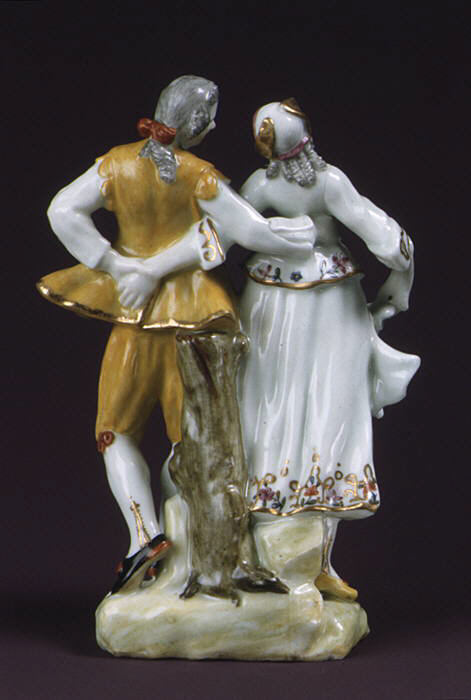Dancing couple
Manufactory Capodimonte Porcelain Manufactory Italian
Model attributed to Giuseppe Gricci Italian
Not on view
This beguiling coupe is one of a collection of fifteen Capodimonte figures and groups that demonstrate the happiest characteristics of that factory’s work. In subject matter—actors, lovers, street vendors—the figures were undoubtedly inspired by the precedent set at Meissen by the models of J. J. Kändler. Apart from its general influence as the first European factory to develop a successful repertoire of porcelain sculpture, Meissen was directly influential in the conception of the Capodimonte factory in 1743: Charels IV, king of Naples, was married to Augustus the Strong’s granddaughter, who is said to have brought with her to Italy no fewer than seventeen Meissen table services. But a difference in material and temperament transformed the brilliantly aggressive character of Kändler’s models into a kinder, occasionally melancholic, interpretation of human nature. The Capodimonte figures are not characters, but people.
The material is soft-paste porcelain of a clear but warm white, covered by a lustrous glaze that on late pieces took on a greenish (eventually an outright turquoise) hue. The figures are simply modeled, and for the most part are colored sparingly, the hemline of jacket or skirt or the open design of a dress pattern emphasizing the clarity of paste and glaze. The most engaging characteristic of Capodimonte sculpture, however, lies in an unerring sense of pose and gesture that creates, in such two-figure compositions as this group, an exceptional sympathy between the figures. The smooth rhythm of the inclination of the bodies, the tilting heads, the sloping shoulders, the linked arms, all establish a mood of gentleness and rapport.
The chief modeler at Capodimonte throughout its existence (1743–59) was Giuseppe Gricci, whose only known signed work is a large dramatic figure of the mourning Virgin that has been in the Museum’s collection since 1971 (1971.92.1). Factory records for the first half-dozen years connect Gricci with a number of well-known Capodimonte subjects, and it is perhaps for this reason that most models are attributed to him. But it must be noted that by 1755 there were six modelers working under Gricci and that over the sixteen years of the factory’s existence gradual but perceptible variations in modeling and painting style occur—perhaps due to other hands. As little is known of the factory after 1750, the attribution and chronology of Capodimonte figures remain somewhat conjectural. It is suggested that this group, with its very slightly tinted glaze, light rendering of facial features, and use of massed areas of color, represents late Capodimonte work.
Several examples of this model are known, and in one the couple wear masks, suggesting they are not simply country dancers, but theatrical performers. In a version in the Museo Teatro della Scala in Milan they have been identified as Flroindo and Columbine from the commedia dell’arte.
Due to rights restrictions, this image cannot be enlarged, viewed at full screen, or downloaded.
This artwork is meant to be viewed from right to left. Scroll left to view more.



